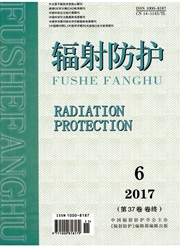

 中文摘要:
中文摘要:
选择我国南方某核厂址两栖动物——蟾蜍作为参考生物,建立了蟾蜍的生物解剖学模型和外照射环境模型。采用蒙特卡罗模拟技术计算源介质中放射性核素^137Cs、^90Sr和^239Pu对靶组织/器官的辐射剂量率,由此计算蟾蜍整体的辐射剂量率。采用ERICA程序和RESRAD-BIOTA程序计算蟾蜍的剂量率,并与解剖学模型进行比较。结果表明:三种方法计算的蟾蜍内照射剂量率基本一致;由于外照射环境模型的不同,外照射剂量率估算结果并不相同,ERICA程序与解剖学模型计算的外照射剂量率结果更接近;解剖学模型关注生物组织/器官的辐射剂量,对于核素分布不均匀的生物个体研究具有重要的意义。
 英文摘要:
英文摘要:
Asiatic toad( Bufo gargarizans) was chosen as the referencing of amphibian at a nuclear site in southern China. The biological anatomy dosimetric model and environmental geometries were established.Using Monte- Carlo simulation techniques,the dose rates of target tissues / organs from media about137 Cs,90Sr and239 Pu were calculated,thereby the dose rates of the whole toad body were calculated. The paper used ERICA tool and RESRAD- BIOTA code to calculate the dose rates of toad,comparing with the anatomical model. The results indicated that dose rates for internal exposure compare well among three approaches. For external exposure,differing environmental geometries assumption,the results of external dose rates were different. The anatomical model concerned with radionuclide distribution in individual tissue / organ is of great importance in investigating the biological individuals that of heterogeneous distribution of radionuclides.
 同期刊论文项目
同期刊论文项目
 同项目期刊论文
同项目期刊论文
 期刊信息
期刊信息
